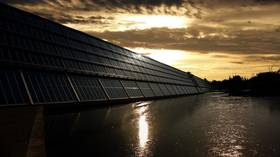‘Reverse’ solar panels could generate power during the NIGHT, scientists working on prototype

The Achilles’ heel of solar energy has always been its inability to generate energy when the Sun is down, but now a team of researchers believes we could soon have solar panels that work 24/7, but… there’s a catch!
Using specially designed photovoltaic cells, scientists now think we could theoretically generate an additional 10 percent or more of the energy produced during the day during night time hours by using the heat lost from the panels as they cool to squeeze out a little extra juice.
These night time photovoltaic cells would work using the same basic principle as normal solar panels, only in reverse. An object that is hotter than its surroundings will radiate heat in the form of infrared light. Regular solar panels absorb the Sun’s heat in the form of visible light.
Such cells are already being tested in the manufacturing industry to convert waste heat from engines and other machinery, but now researchers at UC Davis are working on prototypes to potentially revolutionize commercial solar energy generation.
“We were thinking, what if we took one of these devices and put it in a warm area and pointed it at the sky,” says electrical and computer engineer Jeremy Munday, from the University of California, Davis.
Also on rt.com Not so green after all: Five ‘eco-friendly’ products that actually harm the environmentThe materials used to create the nighttime photovoltaic panels would differ from traditional ones somewhat in order to capture the infrared radiation as it escapes but “the physics is the same” as traditional solar panels say the scientists.
In best case scenario conditions, the researchers believe they could boost energy production by about 12 percent. Munday and his colleagues already have several prototypes in development but unfortunately, they say it will be some time before they can properly scale the devices to meet demand on a larger scale.
Scholars from Stanford are also developing a similar system to generate electricity from infrared radiation.
Like this story? Share it with a friend!














